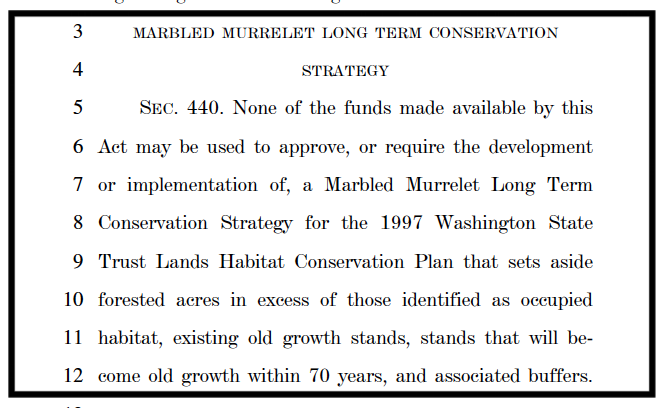What tree surgeon Hoyt Foster discovered in 1974--a Marbled Murrelet chick hunkered down on a branch 148 up a Douglas-fir--provided critical clues to the nesting habitat of this federally threatened little seabird.
Marbled Murrelets need a wide branch, preferably covered in moss, at least 50 feet up a tree that is >150 years old and no more than 55 miles from salt water. This kind of habitat was once amply available along the Pacific Northwest coast. Now, that habitat has been reduced to patches and fragments and the murrelet population has been steadily crashing.
In Washington state, the population has dropped 44% between 2001 and 2015 and continues to decline at the rate of 4% a year. This means, based on the 2016 population in our state, that we will losing 284 murrelets a year. The primary cause is the historic and ongoing logging of our old-growth and mature coastal forests.
On September 7, 2018, the Department of Natural Resources released a long-term conservation strategy that will help determine the fate the of the Marbled Murrelet on the 576,000 acres of land it manages for these birds and other wildlife. Much this acreage is habitat, but not all of it. An estimated 154,000 acres consist of murecelt nesting habitat. As you might imagine, the management of this habitat is hotly contested. The mature and old-growth forests provide both valuable revenue to our state when horizontal; they provide critical habitat to murrelets for nesting when left vertical.
What Marbled Murrelets do not need is Jaime Herrera Beutler, the U.S. Congressperson representing Washington's 3rd district in southwest Washington. Though she believes she is doing the right thing to protect family-wage jobs in her district, her efforts in the murrelet arena are misguided (which is to say guided by the timber industry and misinformation) and will surely backfire if she continues to refuse to understand the basic habitat needs of the murrelet. Her constituents have more to lose than gain by supporting her position on managing our state forest lands.
Rep. Herrera Beutler introduced an amendment to the House Appropriations Bill for Interior & Environment that would essentially result in the logging of everything but the bare essentials for nesting murrelets. Here is the text of her short-sighted bill.
This stingy bill should not be supported. It proposes to protect only the highest-quality forest stands. It will create silos of habitat for the murrelet and other species that benefit from contiguous blocks of forest. It will not contribute to the recovery of this imperiled species. It will not meet the U.S. Fish & Wildlife Services criteria required of the Department of Natural Resources to continue legally harvesting their state trust lands.
Jaime Herrera Beutler's amendment offers a bulldozer at a time when we need are well-honed axes, sharpened pencils, and sharp minds.
In its recently revised Draft Environmental Impact Statement, the Department of Natural Resources has offered several options for protecting forest lands that will eventually grow into murrelet nesting habitat. While it may irk some to set aside younger forests for future murrelet habitat, this is what is needed to give this bird a fighting chance.
Murrelet chick ready to fledge. (Photo courtesy Hamer Environmental).







